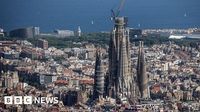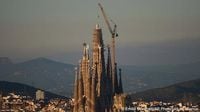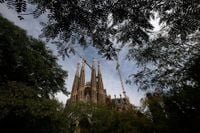Barcelona’s skyline has a new record-breaker. On Thursday, October 30, 2025, the city’s world-renowned Sagrada Familia basilica officially became the tallest church on the planet, overtaking Germany’s Ulm Minster by a slim but decisive margin. The milestone was reached when workers, using a towering crane, placed the first part of a cross atop the basilica’s central tower, known as the Tower of Jesus Christ. The basilica now soars to 162.91 meters (534 feet), nudging past the Ulm Minster’s 161.53 meters (530 feet)—a title the German church had held since its completion in 1890, according to the Associated Press and several other outlets.
The numbers are clear: Sagrada Familia is now just over a meter taller than its German rival. But the story doesn’t end there. The basilica is still growing. In the coming months, the central tower will reach its final planned height of 172 meters (564 feet), making the church’s silhouette even more commanding and unique among the world’s sacred architecture. As the church’s foundation noted, this next stage will see the rest of the cross added to the Tower of Jesus Christ, cementing Sagrada Familia’s place in the record books for years to come.
For Barcelona, this achievement is more than a matter of civic pride—it’s the latest chapter in a saga that began nearly 150 years ago. The first stone of Sagrada Familia was laid in 1882, and the following year, a young architect named Antoni Gaudí took over the project. Gaudí’s vision transformed the original plans into something far more ambitious, blending Catholic symbolism with organic forms inspired by nature. Yet, the scale of his imagination was so vast that he never expected the church to be completed in his lifetime. When Gaudí died unexpectedly in 1926, only one of the planned 18 towers had been finished. The rest would be left to future generations, guided by his models and drawings—a task made all the more difficult when many of those plans were destroyed during the Spanish Civil War.
Despite these setbacks, construction has continued, sometimes haltingly, sometimes in bursts of progress, over the decades. The Sagrada Familia foundation, which has overseen the project since Gaudí’s death, has relied on a mix of donations, ticket sales, and private contributions to keep the work going. In fact, the basilica’s status as a major international tourist magnet has been key to its recent acceleration. In 2024 alone, a staggering 4.9 million people paid to visit the site, with 15% of those tourists traveling from the United States. As the BBC and other sources have reported, these entrance fees directly fund ongoing construction—meaning every ticket sold brings the dream of completion a little closer.
But the journey hasn’t always been smooth. The Spanish Civil War, for instance, saw anarchists set fire to the church’s crypt, destroying invaluable plans and plaster models that would have guided future architects. More recently, the COVID-19 pandemic brought construction to a halt as tourism dried up and funding dwindled. Yet, through each trial, the project has found a way to restart, adapt, and push forward.
The rivalry with Ulm Minster, though friendly, is steeped in history. The German Gothic church, built between 1543 and 1890, had long been the world’s tallest, a point of pride for the city of Ulm and for Lutheran architecture. Now, as the bragging rights shift to Barcelona, the Sagrada Familia’s rise is being celebrated not just as a feat of engineering but as a testament to perseverance and vision. The basilica’s unique blend of soaring spires, intricate facades, and organic curves—so distinctively Gaudí—has captured the imagination of millions worldwide. According to church officials, work on the elaborate facades, sculptures, and the stairway leading to the main entrance will continue for several more years, with full completion of the basilica expected around 2035.
Next year, 2026, will mark the 100th anniversary of Gaudí’s death. The church has announced plans for a series of events to honor his legacy, not only celebrating the Sagrada Familia but also his other architectural masterpieces scattered across Barcelona and Spain. Gaudí himself is buried in the church’s crypt—a fitting resting place for a man whose life’s work continues to shape the city’s identity. As Sagrada Familia General Director Xavier Martínez told the Associated Press, “The Tower of Jesus Christ will be completed in 2026, to coincide with the centenary of Gaudí’s death.”
The Sagrada Familia’s journey has been anything but straightforward. From its humble beginnings, funded by donations from repentant worshippers, to its current status as a global tourist destination, the basilica has weathered wars, economic crises, and even a pandemic. Each obstacle has left its mark, but none has derailed the vision set forth by Gaudí more than a century ago. The foundation overseeing the project has credited the recent surge in tourism with accelerating construction, allowing the team to move forward with both the central tower and the ongoing work on the church’s interior and decorative elements.
For visitors, the appeal is obvious. The basilica’s stunning architecture, with its forest-like columns, intricate stonework, and colorful stained glass, offers an experience unlike any other. Gaudí’s signature style—melding the spiritual with the natural—remains evident in every curve and detail. As the basilica edges closer to completion, anticipation is building not just among locals but among architecture enthusiasts and travelers worldwide.
Looking ahead, the next decade promises to be a momentous one for Sagrada Familia. While the Tower of Jesus Christ will soon reach its final height, work on the facades, sculptures, and interior decoration will continue, ensuring that Gaudí’s vision is realized in full. The centenary celebrations in 2026 are expected to draw even larger crowds, spotlighting the basilica’s enduring significance and the city’s deep connection to its most famous architect.
In the end, Sagrada Familia’s ascent to the top spot among the world’s churches is more than a matter of height. It’s a story of ambition, resilience, and the power of collective effort—a story that, fittingly, is still being written as Barcelona’s skyline changes before our eyes.


